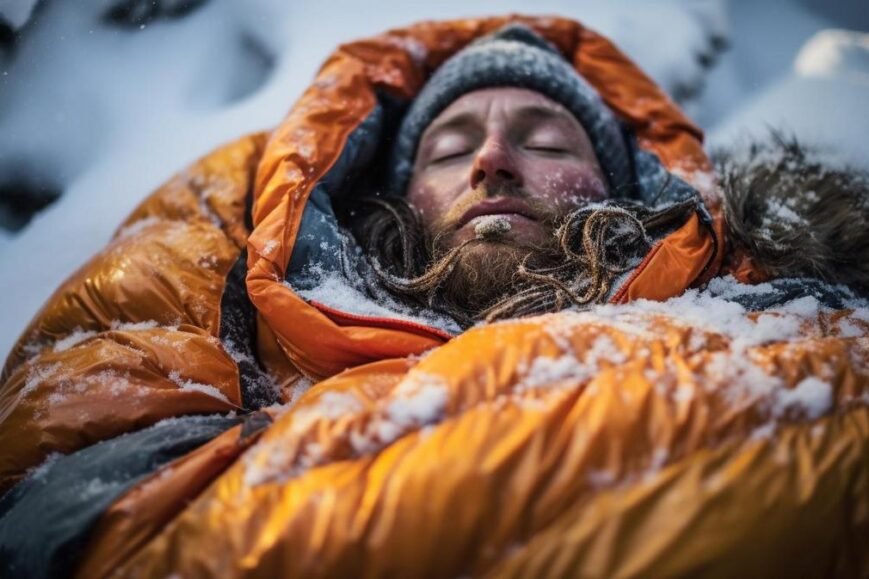- Choose a mummy-style sleeping bag with the right fit for cold weather; it should be snug to trap heat.
- Opt for a bag rated for temperatures lower than you expect to encounter.
- Down insulation is lightweight and warm but performs poorly when wet; synthetic insulation is heavier but retains warmth when damp.
- Select bags with draft collars, hoods, and other features to trap heat.
- For backpacking, consider the weight and packability of the bag.
- A sleeping bag liner can add extra warmth.
- Use a proper sleeping bag liner material for added insulation, such as fleece or thermal.
- Ensure the bag is not too big or too tight and utilize a hood and pillow for additional warmth.
- Prioritize innovations like advanced baffle design, zipper construction, and foot box design for better performance.
- For extreme cold, look for bags with a high fill power (at least 600) and suitable warmth ratings (zero degrees or lower).
- Regularly maintain your sleeping bag by storing it loosely keeping it dry, and cleaning it according to the manufacturer’s instructions.
Brace yourself for the chills; picking the right cold-weather sleeping bag can mean the difference between a cozy night under the stars and a shivering ordeal. Every frosty night adventurer knows it’s not just about staying warm—it’s about conquering the cold. I’ll guide you through what to look for, from insulation battles to snug fits, ensuring you’re geared up to face even the most frigid conditions.
What Should I Look For When Selecting A Cold Weather Sleeping Bag?
What type of sleeping bag is best for cold weather? To start, mummy-style bags offer the best cold resistance. Their snug fit helps keep the heat close to your body all night. Now, let’s dive in and look at what makes these bags so cozy.
Understanding Insulation Types: Down vs. Synthetic
First off, you’ve got two choices: down or synthetic. Down is light and holds heat well, but it won’t help much if it gets wet. Synthetic keeps you warm even when damp and dries fast.
The Importance of Sleeping Bag Shape and Fit
Shape matters too. Mummy-style sleeping bags are the best winter sleeping bags, hugging you tight to shut out drafts. Make sure the bag fits well; a tight fit means better warmth.
Deciphering Sleeping Bag Temperature Ratings
Let’s talk numbers. The temperature rating shows the lowest temperature at which the average sleeper stays warm. So choose a bag rated for temps colder than what you expect to face.
Features That Lock in Warmth: Draft Collars and Hoods
Remember, details like draft collars and hoods make a big difference. They trap heat around your head and neck, crucial spots for staying warm.
Weight and Packability Considerations for Backpacking
If you plan to haul your bag around, think about weight and how small it can pack. Lighter and more compressible bags are easier to carry, so consider those if you’re trekking far.
The Role of Sleeping Bag Liners for Additional Warmth
Lastly, for some added warmth, a liner works wonders. It slips inside your sleeping bag, offering an extra layer that can up the heat on really frosty nights.
With these tips, you’ll find ergonomic and trusty sleeping gear to keep you toasty through the coldest camping trips.

How Do Different Materials Affect The Performance of Cold Weather Sleeping Bags?
Can you use a 20-degree sleeping bag in the winter? Yes, but only if the weather stays above 20°F. For colder times, you’ll need a warmer bag.
Down-filled sleeping bags for winter are light and easy to pack. They trap heat well but lose their warmth if they get wet. Synthetic insulation camping sleep systems are heavier. But, they still work even when damp. Weather-resistant fabrics in sleeping gear help stop wind and water. They keep the insulation dry and you warm.
Pros of down include warmth for its weight and easy packing. But it costs more and fails when wet. Synthetic fills are cheaper and work when wet. The downside is they’re bulkier and not as warm.
Understanding shell materials is key. They protect the insulation inside. A tough shell fights off tears and abrasions. It also shields against harsh winds and keeps out water.
Water resistance in sleeping gear is a must-have. It keeps melting snow or tent condensation away from insulation. That means you stay warm all night long.
Your gear must fit the climate you’re sleeping in. The right bag can mean a good night’s sleep or hours of shivering. Sort out the materials, and you’re set for a cozy sleep, even in deep freeze.
What Are The Best Practices For Using And Maintaining A Cold Weather Sleeping Bag?
Yes, there are 4-season sleeping bags. These bags are sturdy and warm for year-round use. To keep your key winter gear in top shape, you need to care for your cold-weather sleeping bag. Storing your bag right keeps it fluffy and warm. Stuff it loose, not tight. Use a large cotton or mesh bag, not the small sack it came in.
To stop condensation, keep the inside dry. Wipe off any moisture you might bring in. Use a waterproof bivy or tent to block dampness. And pick spots that keep water away.
For cleaning, follow the bag maker’s advice. Usually, less wash is best to protect the fill. Spot clean small messes. Wash it full when it’s really needed. Use a gentle cleaner made for sleeping bags. Air dry it or use a large dryer on low heat. Avoid harsh soap and high heat – they ruin bags.
A squished bag loses loft, which means less warmth. Don’t keep it squashed for too long. For cold trips, a bag that packs small helps. But at home, let it breathe.
Your bag is part of your sleep system. A pad underneath adds warmth. Your wear matters too. Dry, clean clothes keep you and the bag dry. Together, these tips keep you cozy and keen for more adventures.

Can Additional Accessories Enhance My Cold Weather Sleeping Experience?
To stay warm on cold nights, yes, you must use the right accessories. Liners can make your bag warmer. Pillow and hood add-ons offer extra comfort and heat. How gear fits matters too; a snug fit boosts warmth.
Selecting the Right Liner Material for Extra Insulation
Choose a liner that suits your needs for more warmth. Fleece and thermal materials offer the most heat. Silk and cotton can feel good but don’t always add as much warmth.
The Added Warmth and Comfort of Sleeping Bag Accessories
For more warmth, get a hood and a good pillow. They keep your head and neck warm. Hugging a pillow helps, as cold air can enter your bag when you move.
Maximizing Warmth: Understanding the Efficiency of Sleeping Bag Fit
A well-fitted sleeping bag traps heat better. Too big, and you lose warmth. Too tight, and you might cut off blood flow, making you cold. Find one that’s just right for your size.
How Do Design Innovations Impact The Performance of Cold Weather Sleeping Bags?
Cold-weather sleeping bags can handle minus 40 degrees. That’s the coldest temperature most are rated for. These bags keep you warm at such low temperatures with new designs and tech. Let’s dive into how these innovations work.
Baffle design is key in trapping warm air. Innovative baffle design in arctic sleeping bags creates tight compartments. These hold down or synthetic fill even and stop cold spots. Think of baffles like the walls in your home. They keep warmth where you need it – inside.
Zipper construction matters too. A good seal keeps the cold out. Cold-proof sleeping bags often use zippers with special guards. These guards block wind and trap heat. Zippers might seem small, but they are mighty in fighting the freeze.
Footboxes in sleeping bags are not just a space. Foot box design for cold weather sleeping bags gives toes extra room to move. This boosts warmth and comfort. Your feet can stay toasty even when it’s icy outside.
Tech helps sleeping bags fight the cold. New materials and designs make sleeping bag technology advancements for colder climates. We now have bags that are lighter and warmer than ever before. Sleeping outdoors in the winter is tough. But, thanks to these advances, your bag won’t let you down.
Remember, when the snow flurries dance outside, and the world is held in winter’s grip, your sleeping bag is your cocoon of warmth. It relies on smart design from head to toe, ensuring you’re ready for whatever cold comes your way.

How Can I Ensure My Sleeping Bag is Suitable for Extreme Cold Weather Conditions?
Extreme cold calls for extreme gear. Let’s talk ultra-warm sleeping bags. They must fit the bill for zero degrees, be it a mountain top or a snowy forest.
Now, what’s fill power?
It’s how much space an ounce of down takes up.
Picture tiny, fluffy feathers. They trap warm air well, the higher the fill power, the warmer you’ll be. You’ll want a fill power of at least 600 for those icy nights. Good down can get you through a cold night snug and cozy.
Next up, we dive into sleeping bag warmth ratings. Think of these as a survival cheat sheet for the cold. They tell you the lowest temps your bag can take. It’s like your bag’s superhero power against the cold.
Zero degrees is what you’re aiming for here.
But wait, extreme weather survival sleeping bags have more tricks up their sleeve. They team up with what you wear to bed, so don’t skimp on the layers. Add a thermal liner or a fleece jacket when it gets really cold.
Feel like a winter warrior yet? Stick to these tips, and the cold won’t stand a chance.
Conclusion
Choosing the right cold-weather sleeping bag matters. You want one that keeps you warm through chilly nights. Remember, insulation type and sleeping bag shape are key. Look for features like draft collars and hoods to lock in the heat. Don’t forget, that materials and designs can boost warmth too. Proper care will make your bag last. And hey, add a liner or a hood for extra snug. Always check the bag’s temperature ratings for your coldest adventures. Stay warm, stay safe, and happy trails!
![]()

